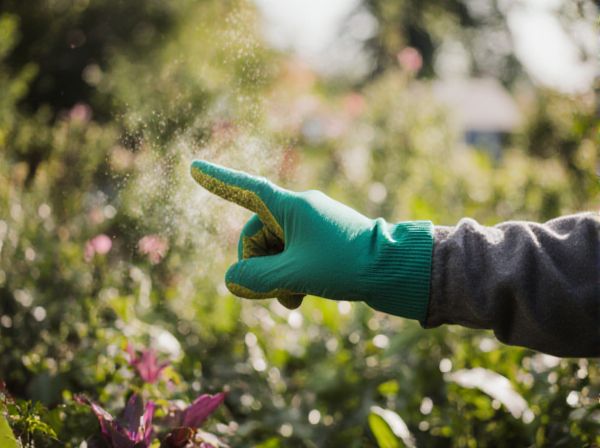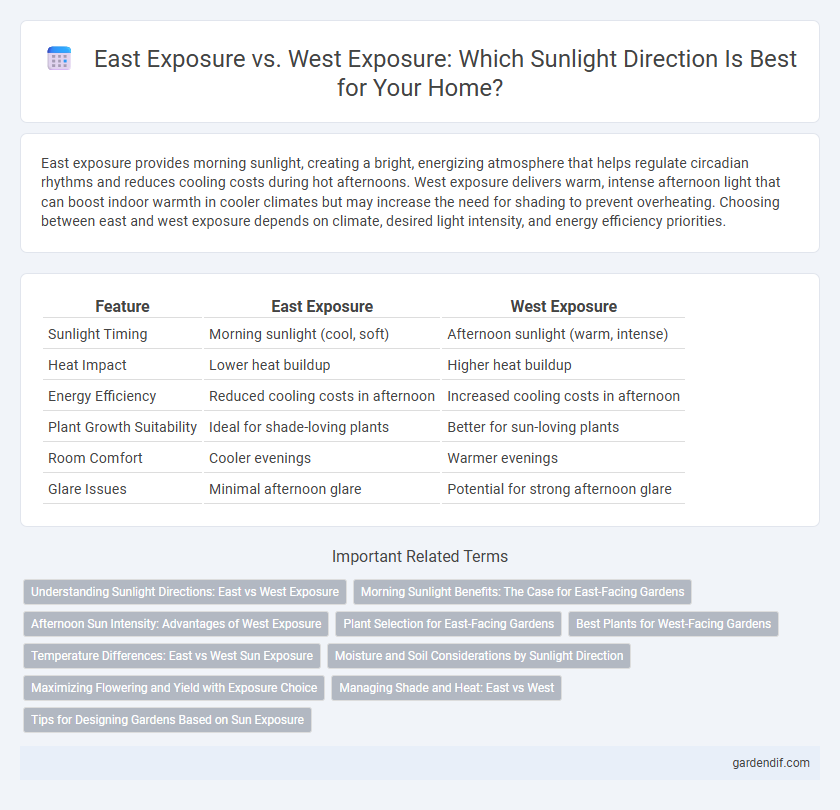
East exposure vs west exposure Illustration
East exposure provides morning sunlight, creating a bright, energizing atmosphere that helps regulate circadian rhythms and reduces cooling costs during hot afternoons. West exposure delivers warm, intense afternoon light that can boost indoor warmth in cooler climates but may increase the need for shading to prevent overheating. Choosing between east and west exposure depends on climate, desired light intensity, and energy efficiency priorities.
Table of Comparison
| Feature | East Exposure | West Exposure |
|---|---|---|
| Sunlight Timing | Morning sunlight (cool, soft) | Afternoon sunlight (warm, intense) |
| Heat Impact | Lower heat buildup | Higher heat buildup |
| Energy Efficiency | Reduced cooling costs in afternoon | Increased cooling costs in afternoon |
| Plant Growth Suitability | Ideal for shade-loving plants | Better for sun-loving plants |
| Room Comfort | Cooler evenings | Warmer evenings |
| Glare Issues | Minimal afternoon glare | Potential for strong afternoon glare |
Understanding Sunlight Directions: East vs West Exposure
East exposure provides morning sunlight that is cooler and less intense, promoting energy efficiency and preventing overheating during the day. West exposure receives stronger, hotter afternoon sunlight, which increases cooling demands and impacts indoor temperature regulation. Understanding these sunlight directions helps optimize natural lighting, energy consumption, and comfort in building design.
Morning Sunlight Benefits: The Case for East-Facing Gardens
East-facing gardens receive abundant morning sunlight, which is rich in gentle UV rays that promote healthy plant growth and enhance photosynthesis. Morning sunlight helps reduce the risk of fungal diseases by drying dew early, creating an ideal environment for many vegetable and flower species. Compared to west exposure, east-facing gardens benefit from cooler temperatures and less intense afternoon heat, making them optimal for growing tender plants.
Afternoon Sun Intensity: Advantages of West Exposure
West exposure provides higher afternoon sun intensity, which benefits plants requiring strong sunlight during later hours for optimal growth and flowering. This prolonged exposure helps enhance photosynthesis efficiency and boosts energy production, supporting robust development. Homes with west-facing windows also enjoy warm evening light, increasing natural warmth and reducing energy usage for heating.
Plant Selection for East-Facing Gardens
East-facing gardens receive gentle morning sunlight, ideal for shade-tolerant and moisture-loving plants such as ferns, hostas, and impatiens. These plants thrive with moderate light and cooler temperatures, avoiding the harsh afternoon sun stress typical of west-facing gardens. Selecting species that prefer indirect sunlight enhances growth and reduces water evaporation in east-exposed landscapes.
Best Plants for West-Facing Gardens
West-facing gardens receive intense afternoon sunlight, making them ideal for sun-loving plants such as lavender, geraniums, and succulents that thrive in warm conditions. Heat-tolerant flowers like marigolds, zinnias, and salvia also flourish in west exposure, benefiting from extended light hours and higher temperatures. To maximize growth, choose drought-resistant species that can withstand the stronger, direct sunlight typical of west-facing environments.
Temperature Differences: East vs West Sun Exposure
East exposure delivers morning sunlight, resulting in cooler temperatures during the day and reducing heat buildup in living spaces. West exposure receives strong afternoon sun, causing warmer temperatures and increasing cooling demands in buildings. Understanding these temperature differences helps optimize energy efficiency and indoor comfort.
Moisture and Soil Considerations by Sunlight Direction
East exposure receives morning sunlight, promoting faster evaporation of soil moisture and reducing the risk of fungal growth in plants sensitive to damp conditions. West exposure experiences intense afternoon sunlight, which increases soil temperature and can lead to quicker drying of the upper soil layers, necessitating more frequent irrigation to maintain adequate moisture levels. Soil with good water retention capacity is essential for west-facing gardens to balance the drying effect of stronger sunlight, while east-facing gardens benefit from moderate moisture retention to prevent excess dampness.
Maximizing Flowering and Yield with Exposure Choice
East exposure provides gentle morning sunlight that enhances photosynthesis early in the day, promoting robust flowering and maximizing yield. West exposure delivers intense afternoon sun, which can increase heat stress but often boosts flowering in heat-tolerant plants. Choosing east-facing sites optimizes balanced light and temperature for sustained flowering and higher overall yield.
Managing Shade and Heat: East vs West
East-facing windows receive gentle morning sunlight that reduces indoor heat buildup and limits cooling costs, making them ideal for managing shade in warmer climates. West-facing exposure captures intense afternoon sun, increasing heat gain and necessitating effective shading solutions like blinds or overhangs to maintain comfortable indoor temperatures. Proper orientation combined with strategic shading improves energy efficiency and indoor climate control in buildings.
Tips for Designing Gardens Based on Sun Exposure
East-facing gardens receive gentle morning sunlight that helps protect delicate plants from harsh afternoon heat, making them ideal for growing leafy greens and herbs. West-facing gardens benefit from strong afternoon sun, suitable for sun-loving plants like tomatoes and peppers, but require strategic shading or drought-tolerant species to prevent heat stress. Incorporate shade structures or mulch in west-exposed areas while ensuring adequate watering schedules tailored to the sun exposure pattern for optimal plant health.
East exposure vs west exposure Infographic

 gardendif.com
gardendif.com